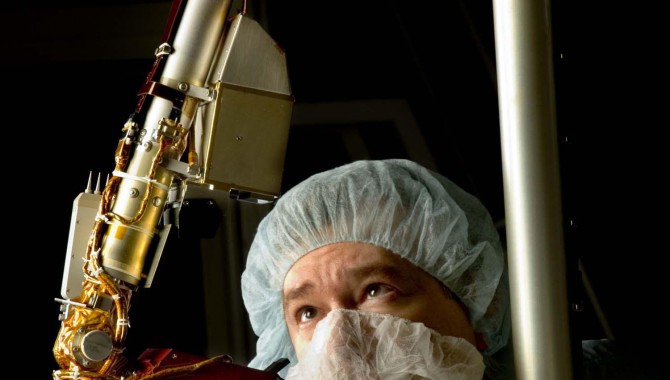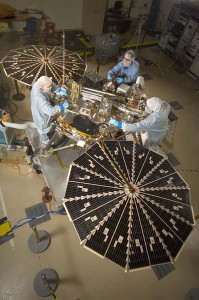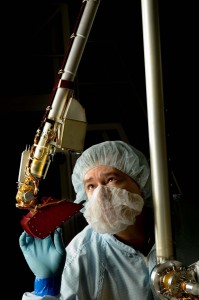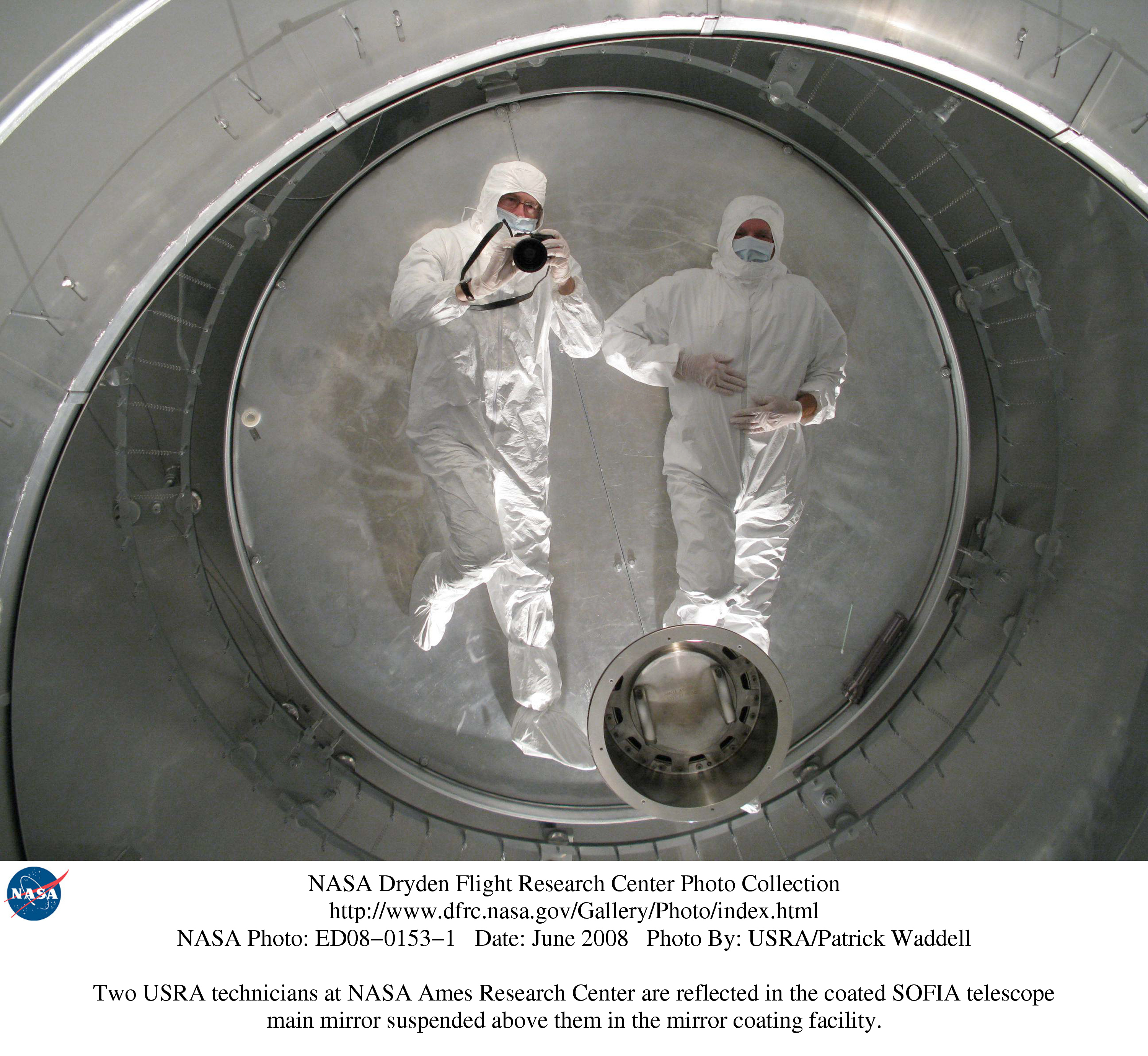
Spacecraft technician Billy Jones inspects the Phoenix Lander’s robotic arm, which was used to dig into the planet’s icy soil to study the history of water and search for complex organic molecules. Photo Credit: NASA/JPL/ UA/Lockheed Martin
By Barry Goldstein
The Phoenix Mars mission was born of failure. Like the mythical Phoenix bird that rose from the ashes of the previous generation’s Phoenix, the mission was born out of the “remains” of earlier attempts.

The Phoenix Mars Lander is lowered into a thermal vacuum chamber at Lockheed Martin Space Systems, Denver, in December 2006.
Photo Credit: NASA/JPL/UA/Lockheed Martin
It used much of the hardware from the Mars Surveyor Lander and carried instruments either identical to or based on those of the Mars Polar Lander. The success of Phoenix is a testament to our ability to learn from our mistakes. The 1998 Mars Polar Lander (MPL) fell silent when it reached Mars in December 1999, a few months after the loss of the Mars Climate Orbiter. The former fell victim to problems during entry, descent, and landing (EDL)—by far the most challenging part of any Mars landing mission. After those failures, the 2001 Mars Surveyor Lander was canceled before launch.
Zealots and Skeptics
As Phoenix project manager, I had no doubts about the importance of getting EDL right. As a competed mission, Phoenix participated in a site visit at Lockheed Martin in Denver in the summer of 2003. When asked by the review team what the three highest priorities were for the development phase of the project, my reply was EDL and EDL followed closely by EDL.
The Phoenix project was selected in August 2003. We held the first EDL team meeting less than two months later. The project as a whole and specifically the EDL team was purposely populated with both zealots for and skeptics of the architectural design. The zealots were the fathers and grandfathers of the 1998 EDL architecture who believed that the failures resulted from limitations imposed by the faster, better, cheaper approach to missions but that the architecture itself was sound. The skeptics were not advocates for that architecture and would take a hard look at every conceivable source of failure.

Spacecraft specialists work on the lander after its fan-like circular solar arrays have been spread open for testing.
Photo Credit: NASA/JPL/
UA/Lockheed Martin
At that first meeting, I told the team, “MER [Mars Exploration Rover] is on its way to Mars. If it lands successfully, we’ll be lucky.” I said it partly for shock effect—we had tested the MER vehicles and architecture as well as any previous spacecraft—but I knew how complicated those systems were. The moment you have confidence is the moment you stop looking for potential problems. That is precisely when overconfidence can lead to disaster. As a team, we would need to stay nervous right up to the point when we knew we had been successful. That is exactly what we did.
The MPL Failure Review Board and the Mars Surveyor Lander Return to Flight Review Board had collectively generated a set of forty-two actions to address presumed weaknesses that could have accounted for the failure of MPL. These actions were to be closed out by our team. At this initial meeting I informed the team, “If all we do is close out these forty-two, I’m going to recommend not to launch, because there’s more out there.” Again, this was partly for shock effect, but it was my sincere belief that if we did our job we would find important issues that were not on that list.
Some New Items
In fact, we found plenty. While testing the separation connectors used to conduct power and signals between the cruise stage and the entry vehicle, we discovered that less than an adequate safety margin existed at the temperatures expected at the time of separation. To increase the margin, we increased mechanical clearance at the core of the connectors and added heaters to make sure that thermal contraction would not further degrade margins.
Detailed assessment of the breakup analysis of our cruise stage, conducted for planetary protection reasons, revealed that some of the components on the cruise stage would not break up on entry; they could actually fly behind the entry vehicle and, given their ballistic characteristics, have the potential to catch up with it. To eliminate this risk, we modified the EDL architecture, altering our sequence so the entry vehicle would turn from sun point to Mars entry attitude after its separation from the cruise stage. This change provided additional lateral separation from between the entry vehicle and the phalanx of shrapnel that could have caught it from behind.
Several other changes were made in the structure and system software to correct for underpredicted loads and functional discrepancies with the landing radar, which was modified for space use. In short, there were over a dozen additional issues with the landing system that the extended Phoenix test and analysis program uncovered and rectified. In some of those cases, the skeptics played the valuable role of making sure our analyses were vigorous and thorough.

Spacecraft technician Billy Jones inspects the Phoenix Lander’s robotic arm, which was used to dig into the planet’s icy soil to study the history of water and search for complex organic molecules.
Photo Credit: NASA/JPL/
UA/Lockheed Martin
Team Dynamics
The composition of the EDL team and the ability of its members to work well together made this work possible. The zealots had essential, intimate knowledge of the EDL architecture; the skeptics questioned every assumption and helped drive us to discover, analyze, and deal with the potential problems. EDL as a technical discipline cannot be separated from the overall spacecraft development, and the Lockheed Martin team that designed, built, and tested the spacecraft welcomed the Jet Propulsion Laboratory team members as part of the development team who contributed to productivity, not just provided oversight. The relationships worked because of mutual respect among members, despite the differences of opinion. They were all professionals, all experienced, all highly skilled, and equally dedicated to the success of the project. Whatever conflict we had was creative conflict, because people took one another seriously and worked together to arrive at answers. This respect increased as we went along. By the time we got to the operational phase of the mission, we truly had a unified team whose individual organizational affiliations were no longer apparent.
Success
Our focus paid off. At launch day in August 2007, we were confident that our continued paranoia was doing its job. On May 25, 2008, we knew that our paranoia could end: Phoenix landed successfully. Phoenix scooped up and analyzed soil from near Mars’s north pole. Along with other data about the planet’s soil and atmosphere, it confirmed the presence of water-ice just below the surface and found evidence of the existence of liquid water in the past.
As expected, the decrease in daylight hours near the pole reduced the solar-electric power available for the lander. Five months after we landed, long after the anticipated threemonth life of its mission, Phoenix stopped communicating with Earth. Dedication, belief, skepticism, and teamwork had been rewarded.









